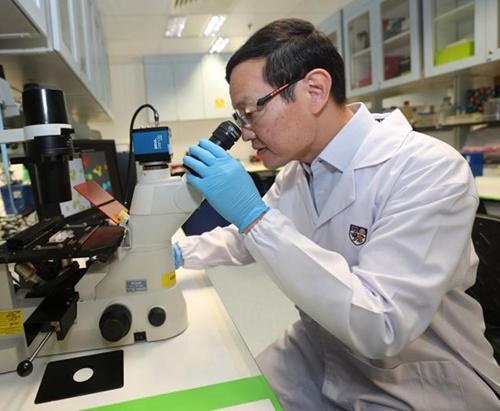The new method employs a pH sensitive dye and AI algorithms to ‘distinguish between cells originating from normal and cancerous tissue, as well as among different types of cancer’ the researchers said
Might a pH-sensitive dye in tandem with an image analysis solution soon be used to identify cancerous cells within blood samples as well within tissue? Recent research indicates that could be a possibility. If further studies and clinical trials confirm this capability, then anatomic pathologists could gain another valuable tool to use in diagnosing cancers and other types of disease.
Currently, surgical pathologists use a variety of hematoxylin and eosin stains (H/E) to bring out useful features in cells and cell structures. So, staining tissue on glass slides is a common practice. Now, thanks to machine learning and artificial intelligence, anatomic pathologists may soon have a similar tool for spotting cancer cells within both tissue and blood samples.
Researchers at the National University of Singapore (NUS) have developed a method for identifying cancer that uses a pH sensitive dye called bromothymol blue. The dye reacts to various levels of acidity in cancer cells by turning colors. “The pH inside cancer cells tends to be higher than that of healthy cells. This phenomenon occurs at the very early phases of cancer development and becomes amplified as it progresses,” Labroots reported.
In “Machine Learning Based Approach to pH Imaging and Classification of Single Cancer Cells,” published in the journal APL Bioengineering, the NUS researchers wrote, “Here, we leverage a recently developed pH imaging modality and machine learning-based single-cell segmentation and classification to identify different cancer cell lines based on their characteristic intracellular pH. This simple method opens up the potential to perform rapid noninvasive identification of living cancer cells for early cancer diagnosis and further downstream analyses.”
According to an NUS news release, the bromothymol blue dye is “applied onto patients’ cells” being held ex vivo in cell culture dishes. The dye’s color changes depending on the acidity level of the cancer cells it encounters. Microscopic images of the now-visible cancers cells are taken, and a machine-learning algorithm analyzes the images before generating a report for the anatomic pathologist.
The NUS researchers claim the test can provide answers in about half an hour with 95% accuracy, Labroots reported.
“The ability to analyze single cells is one of the holy grails of health innovation for precision medicine or personalized therapy. Our proof-of-concept study demonstrates the potential of our technique to be used as a fast, inexpensive and accurate tool for cancer diagnosis,” said Lim Chwee Teck, PhD, NUS Society Professor and Director of NUS’ Institute for Health Innovation and Technology, in the NUS news release.

The novel technique for differentiating cancer cells from non-cancerous cells being developed at the National University of Singapore (NUS) could eventually become useful in detecting cancer cells in tissue samples, either obtained from tumor biopsies or blood samples. “As the number of cells in these samples can be in millions or even billions, the ability to detect the very few cancer cells among the others will be useful for clinicians,” NUS Society Professor and Director of NUS’ Institute for Health Innovation and Technology, Lim Chwee Teck, PhD (above) told The Straits Times. (Photo copyright: The Straits Times.)
AI Cell Analysis versus Laborious Medical Laboratory Steps
By developing an AI-driven method, Professor Lim and the NUS team sought to improve upon time-consuming techniques for identifying cells that traditionally involve using florescent probes, nanoparticles, and labeling steps, or for cells to be fixed or terminated.
“Unlike other cell analysis techniques, our approach uses simple, inexpensive equipment, and does not require lengthy preparation and sophisticated devices. Using AI, we are able to screen cells faster and accurately,” Professor Lim told Labroots. “Furthermore, we can monitor and analyze living cells without causing any toxicity to the cells or the need to kill them.”
The new technique may have implications for cancer detection in tumor tissue as well as in liquid biopsies.
“We are also exploring the possibility of performing the real-time analysis on circulating cancer cells suspended in blood,” Professor Lim said in the NUS news release. “One potential application for this would be in liquid biopsy where tumor cells that escaped from a primary tumor can be isolated in a minimally-invasive fashion from bodily fluids such as blood.”
Diagnosing Cancer in Real Time
The NUS’ method requires more research and clinical studies before it could become an actual tool for anatomic pathologists and other cancer diagnosticians. Additionally, the NUS researchers acknowledged that the focus on only four cell lines (normal cells, benign breast tumor cells, breast cancer cells, and pancreatic cancer cells) limited their study, as did lack of comparison with conventional florescent pH indicators.
Still, the NUS scientists are already planning more studies to advance their concept to different stages of cell malignancy. They envision a “real-time” version of the technique to enable recognition of cells and fast separation of those that need to be referred to clinical laboratories for molecular testing and/or genetic sequencing.
Medical laboratory leaders may want to follow the NUS study. An inexpensive AI-driven method that can accurately detect and classify cancer cells based on pH within the cells is provocative and may be eventually become integrated with other cancer diagnostics.
—Donna Marie Pocius
Related Information
Machine Learning-Based Approach to pH Imaging and Classification of Single Cancer Cells
Machine Learning Can Identify Cancerous Cells by Their Acidity
AI Test Distinguishes Cancer Cells from Healthy Ones Based on Acidity Levels



